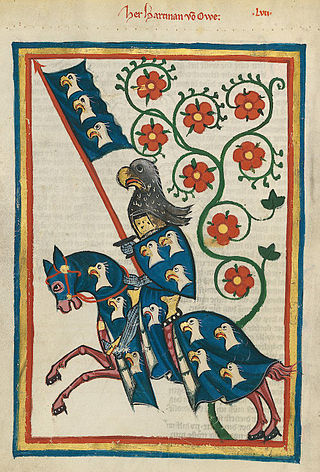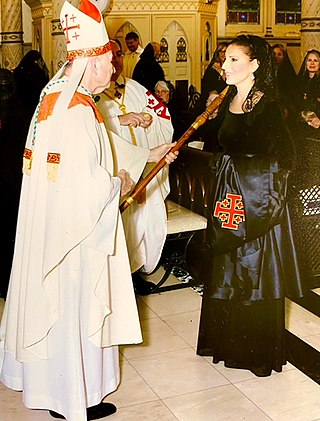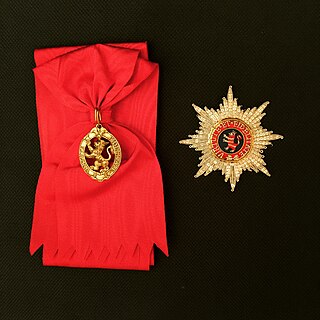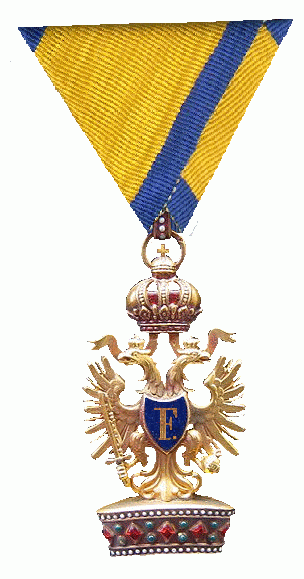
A knight is a person granted an honorary title of knighthood by a head of state or representative for service to the monarch, the church or the country, especially in a military capacity. Knighthood finds origins in the Greek hippeis and hoplite (ἱππεῖς) and Roman eques and centurion of classical antiquity.

The Distinguished Order of the Golden Fleece is a Catholic order of chivalry founded in Bruges by Philip the Good, Duke of Burgundy, in 1430, to celebrate his marriage to Isabella of Portugal. Today, two branches of the order exist, namely the Spanish and the Austrian Fleece; the current grand masters are Felipe VI, King of Spain and Karl von Habsburg, head of the House of Habsburg-Lorraine, respectively. The Grand Chaplain of the Austrian branch is Cardinal Christoph Schönborn, Archbishop of Vienna.
A dynastic order, monarchical order, or house order is an order under royal patronage. Such an order is bestowed by, as a legitimate fons honorum, a sovereign or the head of a once-sovereign ruling family. These are often considered part of the cultural patrimony of the ruling family. Dynastic orders were often founded or maintained to reward service to a monarch or their subsequent dynasty.

The Royal Military Order of Saint George for the Defense of the Faith and the Immaculate Conception, also known as the Royal Bavarian House Equestrian Order of Saint George, was founded by Maximilian II Emanuel, Elector of Bavaria in 1726 to provide for a means of honouring the nobility and recognizing distinguished civil and military service. Its status as a Catholic Order was confirmed in a papal bull of 15 March 1728 specifically comparing the Order with the Teutonic Order, which had likewise been transformed from a Crusading Order to an exclusive chivalric religious institution for the Nobility.

Dame is an honorific title and the feminine form of address for the honour of damehood in many Christian chivalric orders, as well as the British honours system and those of several other Commonwealth realms, such as Australia and New Zealand, with the masculine form of address being Sir. It is the female equivalent for knighthood, which is traditionally granted to males. Dame is also style used by baronetesses in their own right.

The Order of the Annunciation, not to be mistaken with Savoy and Italy's Supreme Order of the Most Holy Annunciation, was a chivalric order founded in 1619 by Charles Gonzaga, Duke of Mantua and Montferrat, Duke of Nevers and soon flourished.
The Noble Order of Saint George of Rougemont was a baronial order of chivalry established around 1440 in the Free County of Burgundy. From the 15th through the late 18th centuries it enjoyed the protection of the Dukes of Burgundy and later the French kings. It was abolished in the wake of the French Revolution and became extinct after the death of the last knight in 1869.

The Austrian Imperial Order of Leopold was founded by Franz I of Austria on 8 January 1808. The order's statutes stipulated only three grades: Grand Cross, Commander and Knight. During the war, in common with the other Austrian and later Austro-Hungarian decorations, crossed swords were instituted to reward bravery in the face of the enemy.

The House Order of the Golden Lion was an order of the German Landgraviate and Electorate of Hesse-Kassel and later, the Grand Duchy of Hesse and by Rhine. It was first instituted in 1770 by Landgrave Frederick II, in honour of and under the patronage of Saint Elizabeth of Hungary, an ancestor of the House of Hesse, and was intended to award auspicious merit.

The Order of the Ancient Nobility, also called Order of the Four Roman Emperors or Ancient Order of Saint George, is a historic chivalric order, first established in 1308. It was re-founded as a secular community on 6 December 1768 by Count Philipp Ferdinand of Limburg-Stirum.

The Ordre du Croissant was a chivalric order founded by Charles I of Naples and Sicily in 1268. It was revived in 1448 or 1464 by René I, king of Jerusalem, Sicily and Aragon, to provide him with a rival to the English Order of the Garter. René was one of the champions of the medieval system of chivalry and knighthood, and this new order was neo-Arthurian in character. Its insignia consisted of a golden crescent moon engraved in grey with the word LOZ, with a chain of 3 gold loops above the crescent. On René's death, the Order lapsed.
The Order of the Ermine was a chivalric order of the 14th and 15th centuries in the Duchy of Brittany. The ermine is the emblem of Brittany. In the 20th century, it was revived by the Cultural Institute of Brittany as an honor for those contributing to Breton culture.

The Imperial Order of the Iron Crown was one of the highest orders of merit in the Austrian Empire and Austria-Hungary until 1918. It was founded in 1815 by Emperor Franz I of Austria as a re-establishment of the original Order of the Iron Crown, which previously had been an order of the Napoleonic Kingdom of Italy.
The Order of the Crown is an order founded by the northern French nobleman Enguerrand VII, Lord of Coucy in 1378 and belongs to the historical orders of France.
The Order of the Belt of Hope was a knighthood order which was founded in 1389 by King Charles VI of France and dedicated it to "Our Lady who bring back home the lost hunters".
The 'Order of the Greyhound' was founded in 1416 in the Duchy of Bar. One also called this chivalric order, the "Order of the Faithfulness"
In 1369, Louis II "the Good", duke of Bourbon founded the Knights of the Golden Shield to commemorate the release from English captivity of noble hostages held along with the king John II of France. This release came in 1369, three years after the death of the captive king.

The Order of Our Lady of the Thistle was founded in January 1370 in Moulins, by Louis II "the Good", Duke of Bourbon « in the honour of God and the Immaculated Virgin», at the occasion of his marriage with Anne of Auvergne, Heiress Countess of Forez, daughter of Beraud II, Dauphin of Auvergne and Jeanne of Forez; niece of John, Count of Forez.
The Order of the Knights Bannerets was a French knighthood mentioned in a biography of Sir Robert Bruce Cotton, 1st Baronet (1570-1631) by Thomas Smith.

The Order of Merit of Philip the Magnanimous was an order of chivalry established by Louis II, Grand Duke of Hesse on 1 May 1840, the name day of Philip I, Landgrave of Hesse, in his honour to award extraordinary military or civil merit. It was the second-highest order of the Grand Duchy of Hesse before 1876, when it was displaced to third by the revived Order of the Golden Lion, the former paramount order of the Electorate of Hesse.